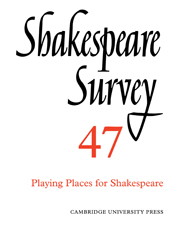Book contents
- Frontmatter
- Shakespeare Played Small: Three Speculations about the Body
- The Architecture of the Fortune Playhouse
- The Bare Island
- ‘How Chances it they Travel?’ Provincial Touring, Playing Places, and the King’s Men
- Writing for the Metropolis: Illegitimate Performances of Shakespeare in Early Nineteenth-Century London
- The Perishable Body of the Unpoetic: A. C. Bradley Performs Othello
- Playing Places for Shakespeare: The Maddermarket Theatre, Norwich
- ‘A Fairly Average Sort of Place’: Shakespeare in Northampton, 1927–1987
- The Living Monument: Self and Stage in the Criticism and Scholarship of M. C. Bradbrook
- Stratford Stages: Interviews with Michael Reardon and Tim Furby, and Sam Mendes
- Dis-Covering the Female Body: Erotic Exploration in Elizabethan Poetry
- Theseus’ Shadows in A Midsummer Night’s Dream
- ‘Time for Such a Word’: Verbal Echoing in Macbeth
- Shakespeare’s Knowledge of Italian
- Tamburline and Edward Alleyn’s Ring
- Shakespeare Performances in England, 1992–1993
- Professional Shakespeare Productions in the British Isles, January-December 1992
- The Year's Contributions to Shakespeare Studies 1 Critical Studies
- 2 Shakespeare’s Life, Times, and Stage
- 3 Editions and Textual Studies
- Books Received
- Index
Theseus’ Shadows in A Midsummer Night’s Dream
Published online by Cambridge University Press: 28 March 2007
- Frontmatter
- Shakespeare Played Small: Three Speculations about the Body
- The Architecture of the Fortune Playhouse
- The Bare Island
- ‘How Chances it they Travel?’ Provincial Touring, Playing Places, and the King’s Men
- Writing for the Metropolis: Illegitimate Performances of Shakespeare in Early Nineteenth-Century London
- The Perishable Body of the Unpoetic: A. C. Bradley Performs Othello
- Playing Places for Shakespeare: The Maddermarket Theatre, Norwich
- ‘A Fairly Average Sort of Place’: Shakespeare in Northampton, 1927–1987
- The Living Monument: Self and Stage in the Criticism and Scholarship of M. C. Bradbrook
- Stratford Stages: Interviews with Michael Reardon and Tim Furby, and Sam Mendes
- Dis-Covering the Female Body: Erotic Exploration in Elizabethan Poetry
- Theseus’ Shadows in A Midsummer Night’s Dream
- ‘Time for Such a Word’: Verbal Echoing in Macbeth
- Shakespeare’s Knowledge of Italian
- Tamburline and Edward Alleyn’s Ring
- Shakespeare Performances in England, 1992–1993
- Professional Shakespeare Productions in the British Isles, January-December 1992
- The Year's Contributions to Shakespeare Studies 1 Critical Studies
- 2 Shakespeare’s Life, Times, and Stage
- 3 Editions and Textual Studies
- Books Received
- Index
Summary
As I was going up the stair I met a man who wasn't there, He wasn't there again today. I wish, I wish he'd stay away.
It is often noted that A Midsummer Night’s Dream shares with Love’s Labour’s Lost and The Tempest a common lack of a clearly defined adequate narrative source. As Stanley Wells remarks in his essay ‘Shakespeare without Sources’
We are accustomed to the study of Shakespeare’s plays by way of his sources. It is a common, and often rewarding, critical technique. But there are a few plays in which Shakespeare did not adapt existing sources . . . Other plays might almost be included in this list, and even these three show the influence of his reading, though in them the influence is local rather than pervasive. But in these three plays Shakespeare seems himself to have been responsible for the main story line, however much he may have drawn on his reading for points of detail.
That seems unexceptionable and my summary of it in my phrase 'clearly defined adequate narrative source' perhaps equally so. There are no sources for A Midsummer Night's Dream sufficient to identify all the elements of the action — Theseus, lovers, fairies and workers — nor even any three of the list. There are, though, many ways of rethinking this view in relation to the play. One could argue that across a remarkable number of features Chaucer's 'Knight's Tale' constitutes a sufficient narrative source for at least much of A Midsummer Night's Dream, more than the framework of Theseus and his marriage.
- Type
- Chapter
- Information
- Shakespeare Survey , pp. 139 - 152Publisher: Cambridge University PressPrint publication year: 1994
- 3
- Cited by



